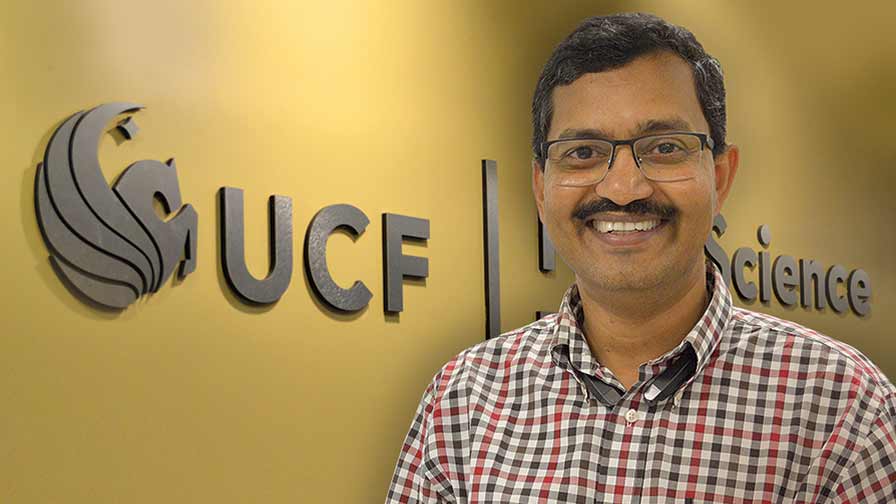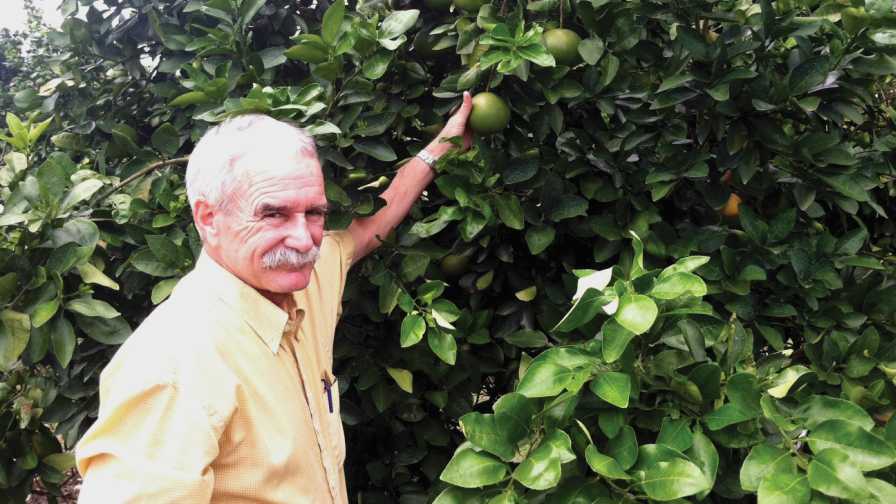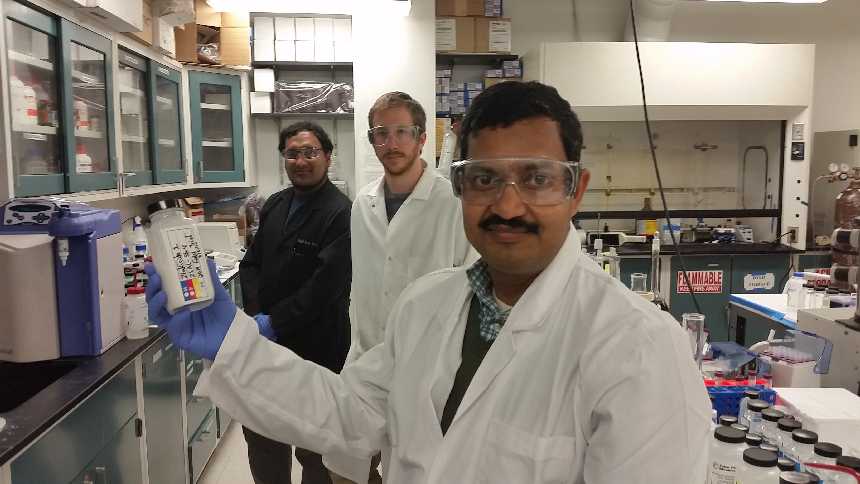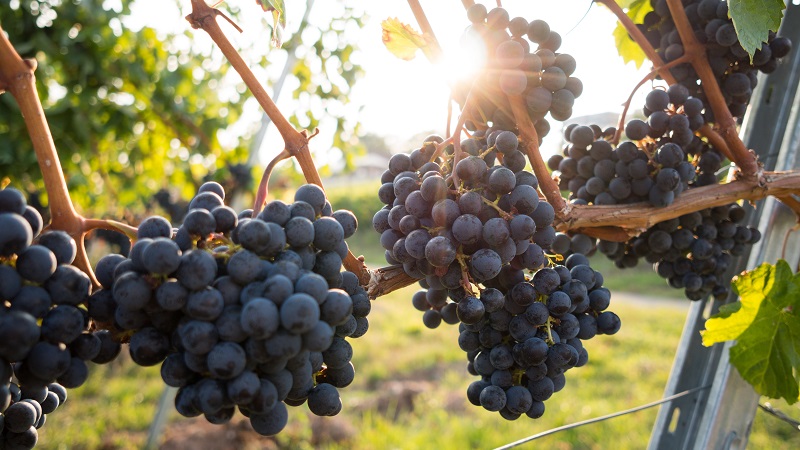UCF Stepping up to Be Farming’s Knight in Shining Armor

University of Central Florida’s Dr. Swadesh Santra is charging his students and fellow researchers to fight the good fight for farmers.
Photo by Frank Giles
While the University of Central Florida (UCF) is a world class institution with one of the largest enrollments in the country, it is not a school that jumps to mind when considering agricultural research. But, this could be changing as a new center of excellence was established there with a focus on sustainable agriculture. In addition, a number of other ag projects engaging the latest in technology are being researched at the university.
The Materials Innovation for Sustainable Agriculture (MISA) Center of Excellence was launched at the beginning of the year. The Center was initiated as part of a $1.9 million research grant from the USDA awarded to Dr. Swadeshmukul (Swadesh) Santra, an Associate Professor in UCF’s NanoScience Technology Center and Department of Chemistry.
 “MISA is a training platform for our young faculty and younger generation,” Santra says. “We have many undergraduates who never thought about selecting agricultural research as their profession, so MISA will motivate them to follow this career path.”
“MISA is a training platform for our young faculty and younger generation,” Santra says. “We have many undergraduates who never thought about selecting agricultural research as their profession, so MISA will motivate them to follow this career path.”
MISA has set lofty goals, seeking to become a global platform for scientists, growers, regulatory agencies, and the industry to exchange ideas and skills. The Center plans to coordinate research efforts, improve academic and public education on agricultural diseases, and develop practical and economically feasible treatment methods.
To say MISA came to be by happenstance is not too much of an overstatement. Santra moved to UCF from the University of Florida in 2005. His work focused mostly on human health and biomedical research in the beginning.
Not long after Santra had received tenure at UCF, he was approached by undergraduate student Tamre Parsons about citrus canker. Having grown up in Central Florida, she expressed interest in conducting a research project that might help growers dealing with the bacterial disease because she knew friends and neighbors impacted by canker.
“When she asked me if I knew anything about citrus canker, I said: ‘No, what is it?’” Santra says. “So, I told her let’s do a Google search on citrus canker. We quickly saw all the results and it was clear this was a real problem for growers.”
That Google query was the beginning of what would eventually evolve into the MISA Center. The search also netted a lot of results from the UF/IFAS Citrus Research and Education Center in Lake Alfred. Santra noted a good deal of research authored by Dr. Jim Graham, a Professor of soil microbiology (retired).

Dr. Jim Graham, UF/IFAS, stands in fruit of a grapefruit tree treated with Zinkicide.
Photo courtesy of UF/IFAS
“Tamre emailed Dr. Graham that we would be interested in learning more about the canker problem,” Santra says. “He sent back a lengthy reply about the problem and current standards in the industry. And, he felt that our email was important because nanotechnology could lead to some new opportunities to managing the disease.”
Santra assigned Parsons a small project working on nanoparticles and silica. “We know silica is a good material to chelate copper, and since copper was already on the market, we decided to see if there were ways to improve the efficacy of the compound. This is how the whole program started.”
Santra has since worked closely with UF/IFAS to test new materials in greenhouses and in field trials. Grove trials since 2009 have shown good results with the copper-based material developed by Santra and his team.
One of the principles that has guided Santra’s agricultural research came from Dr. Tom Turpen, who is a project manager for the Citrus Research and Development Foundation (CRDF). CRDF has funded some of the agricultural work being conducted by Santra and his team.
“Dr. Turpen said to me whatever you make, it should be dirt cheap and something you could make in your Grandma’s kitchen,” Santra says. “In other words, if the technology is expensive and outside of the growers’ budget and it is very complex to manufacture, then forget about it. CRDF has to be wise with the growers’ box tax money, so I always keep this in mind for myself and when I am teaching our students.”
This focus on applied research is bearing fruit. Recently, Gowan Co. signed a license agreement with UCF for exclusive rights to manufacture and distribute Santra’s product, which couples copper with cutting-edge nanoscience. The product contains high surface copper particles to improve copper bio-availability. This allows for lower use rates while maintaining efficacy.
Gowan intends to bring the product to market for use on a wide range of fruits and vegetables, including citrus, potatoes, tomatoes, watermelons, berries, and more. The agreement represents the first time a UCF discovery has been licensed for the agricultural industry.
“In my opinion, this is groundbreaking,” says Andrea Adkins, Assistant Director of UCF’s Office of Research and Commercialization. “It is a forerunner of everything coming from UCF in agriculture.”

Dr. SwadeshnSantra holds a sample of Zinkicide in his UCF nanotechnology lab.
Photo courtesy of UCF
Targeting Greening
As Santra and his research group developed the copper formulation for citrus canker, he observed that more research focus was being applied to greening due to its devastating impact on the industry.
“In 2013, I was attending the International Research Conference on HLB in Orlando learning more about the disease and how really difficult it is,” Santra says. “At lunch during the meeting, I talked with one of the growers there and heard how panicked they were about greening. My sympathy is for the growers, especially the smaller ones who don’t have the [financial] reserves to wait for many years for solutions.”
During that meeting, Santra began sketching out the design of a new compound on the note pads supplied on the conference tables. Later that day, he began work on the zinc-based antimicrobial in his lab. The product is called Zinkicide.
The product, a nano-based technology, aims for better leaf penetration. A study by UF/IFAS indicates that a particle size bigger than 5.8 nanometers is too large for plant tissue penetration. The latest Zinkicide formulation that will be going commercial, pending registration, has a particle size of less than 5 nanometers.
Several grants from CRDF and USDA’s National Institute of Food and Agriculture was critical in the development of the product. It will be targeted toward canker initially, but research is underway to study its impact on greening. BRANDT and Trademark Nitrogen have entered into an agreement to take Zinkicide to market.
“The company registrants are fired up about this technology,” Santra says. “We know the science and the companies know how to manufacture and market it on a commercial scale.”
Because the nanotechnology approach is so unique, EPA has indicated Zinkicide will be treated as a new active ingredient. However, because it is a product based entirely on natural plant-based materials, it sets up to be registration friendly by the agency. You have to think about all of these things in the design of a material,” Santra says. “It has to be safe for the environment and human health and something that can be 100% absorbed by the plant. That’s how we designed Zinkicide.”
Collaboration Seeking Solutions
Santra says he can’t emphasize the importance that collaboration has played in the development of the MISA Center and the new technology being developed by it. Santra teamed up with his UCF colleagues (Andre Gesquiere, Laurene Tetard, Karin Chumbimuni-Torres, Woo Hyoung Lee) and outside UCF collaborators, Evan Johnson and Jim Graham (UF-IFAS), Leonardo De La Fuente (Auburn University), Nicole Labbe (University of Tennessee), Loukas Petridis (Oak Ridge National Lab).
“I give Dr. Graham so much credit for planting the seed and educating us on the problem,” he says. “We spend hours talking about agricultural challenges. He is a great motivator.”
Graham says the application of nanotechnology will broaden the application of practical solutions to disease control. “Dr. Santra has extraordinary insight on what is needed to overcome existing limitations of chemical formulations for plant pathogen control,” he says.
Santra says UCF and the MISA Center of Excellence are proud to join the fight and inspire future generations in the mission of feeding a rapidly growing global population.
“To achieve higher production levels, technological advancements are warranted to protect crops against emerging threats, particularly microbial-origin diseases,” he says. “There is no better time than now to secure our future while minimizing the negative impacts on our environment.”

This ground robot is being designed by UCF researchers and students to monitor diseases in strawberries.
Photo courtesy of UCF
Rise of the Machines
While MISA is the first ag-related center at UCF, there is more agricultural research being conducted on the Orlando campus. Mechanical engineering Associate Professor Dr. Yunjun Xu and a group of his students have been creating robots since 2013 when Xu and UF/IFAS agricultural engineer and Associate Professor Dr. Reza Ehsani landed a USDA grant worth more than $1.2 million. The goal is to develop an automated system that would use robots and specialized sensors to detect and report disease in strawberry fields.
“Our ag robotic project is about using cooperative ground and unmanned aerial vehicles to conduct rapid and early disease detections,” Xu says. “Hopefully, with this new robotic technology, we can significantly lower the ever-increasing labor cost in scouting throughout agriculture fields. A scaled-down version of the system is currently being tested in commercial strawberry fields.”
The goal is to create a system that can be remotely controlled or done autonomously by the robots. “The autonomous capabilities are not fully implemented yet and currently under testing,” Xu says. “It is a challenging task for the robot to go through the fields, and in the meantime, consider different terrain conditions, bed structures, lighting conditions, and varying tree/leaf geometries, just to name a few. Overall, we have achieved promising results and much work still needs to be done.”
More research projects are underway including another collaboration with Ehsani to design a robotic, autonomous heat treatment system for citrus trees infected with greening.










